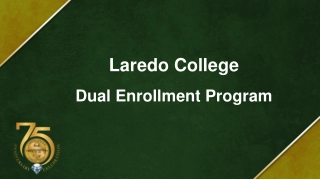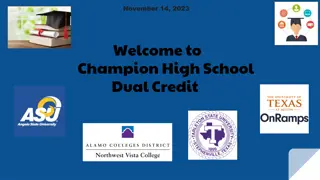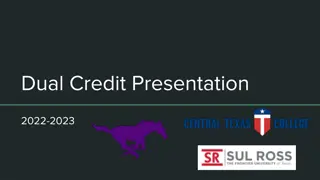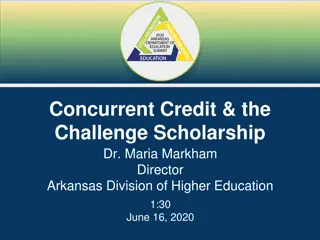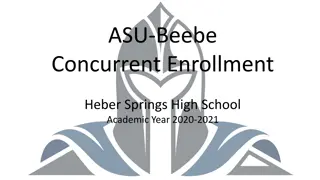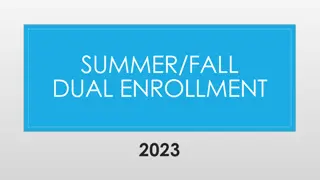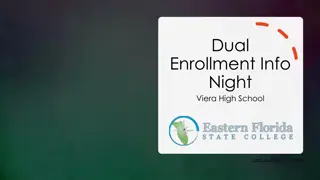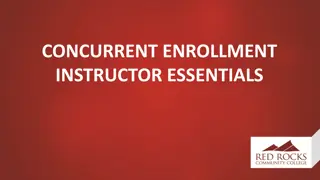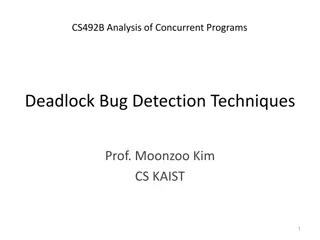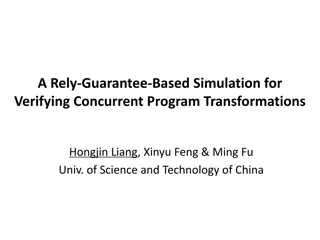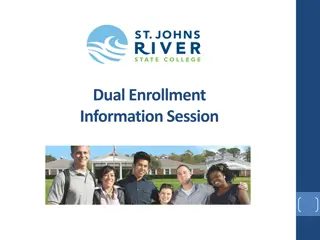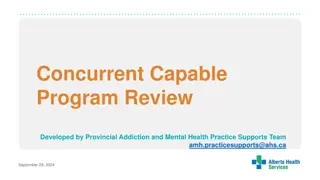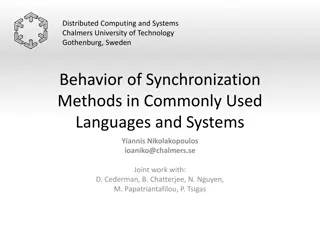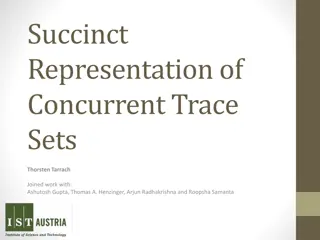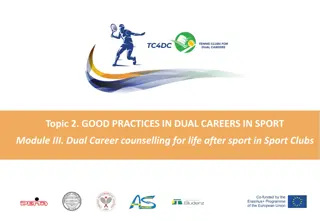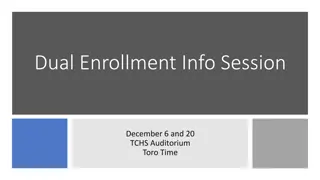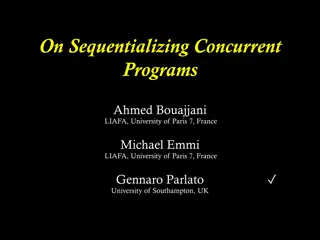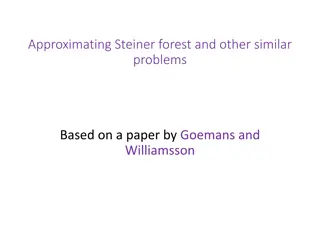Understanding Dual Enrollment and Concurrent Enrollment
At the state level, there is no formal distinction between Dual Enrollment and Concurrent Enrollment. Special admit students refer to high school students taking college courses. Courses under CCAP agreements aim to make dual enrollment accessible to all students. Regulations for CCAP students include completing one application, parental consent, and perks like fee exemptions. Non-CCAP students follow Education Code guidelines.
Download Presentation

Please find below an Image/Link to download the presentation.
The content on the website is provided AS IS for your information and personal use only. It may not be sold, licensed, or shared on other websites without obtaining consent from the author. Download presentation by click this link. If you encounter any issues during the download, it is possible that the publisher has removed the file from their server.
E N D
Presentation Transcript
GPA and Concurrent GPA and Concurrent Enrollment Enrollment
First, some terms First, some terms At the state level, there is no formal distinction between the terms Dual Enrollment and Concurrent Enrollment. Some schools differentiate between the two but this is a local definition and is not done uniformly across institutions. Instead, the state refers to high school students who take college courses as special admit students.
First, some terms First, some terms According to the state, there are only two main tracks for special- admit students: CCAP high school students who enroll in courses offered under AB288 and AB30 Non-CCAP special admit students taking courses not offered under AB288/AB30. For the purposes of this PowerPoint, we will use the terms dual enrollment and concurrent enrollment interchangeably to refer to all special-admit students.
An overview of CCAP An overview of CCAP Courses offered under AB288 and AB30 are done so through a College and Career Access Pathway (CCAP) Agreement. For the 2021-22 Academic Year, SBVC will have active CCAP Agreements in place with San Bernardino City Unified School District, Rialto Unified School District, PAL Charter Academy, Entrepreneur High School, and Norton Science and Learning Academy. The goal of CCAP is to make dual enrollment accessible to all students, not just scholastically advanced students.
Regulations related to CCAP Dual Enrollment Regulations related to CCAP Dual Enrollment Students must only complete one application during the duration of CCAP participation Only one parental consent is required for the duration of CCAP participation Courses offered on the high school campus can be closed to traditional SBVC students Students taking only CCAP courses can enroll in up to 15 units per semester. Sequences of courses are carefully planned for specific high schools. Only students from that high school enrolling in the planned courses are counted as CCAP students. CCAP students are exempt from tuition fees, student representation fees, transcript fees, non-resident fees (except through Labor Code 3074.7), and child development center fees
An overview of non An overview of non- -CCAP CCAP Unless specifically mentioned in AB288 or AB30, the Education Code for non-CCAP special admit students applies to special admit students on the CCAP track. The population of non-CCAP concurrent enrollment students is incredibly diverse. This includes: High School students in Middle College High School students taking SBVC courses offered at their high school campuses High School students coming to SBVC to take courses that interest them Adult School students in a High School Diploma Program Adult School students in a High School Equivalency Certificate Program
Regulations related to Non Regulations related to Non- -CCAP Dual Enrollment Enrollment CCAP Dual Important laws to note: All High School students must attend high school at least part time (at least 180 minutes of high school instruction per day) in order to qualify for dual enrollment Non-CCAP dual enrollment students may take up to 11 units per semester All dual enrollment students require the recommendation of their high school principals Non-CCAP courses must be open to all SBVC students and published online at least 30 days prior to the start of class All dual enrollment students, except for nonresident aliens as outlined in paragraph (15) of subsection (a) of Section 1101 of Title 8 of the United States Code, are considered residents for tuition purposes
Regulations related to all Dual Enrollment Regulations related to all Dual Enrollment Admission may be limited based on: Age, Grade level Assessment instruments, methods, or procedures Currently, the Guided self-placement is not being used to determine eligibility for Admission. Students are being denied based on high school GPA prior to completing the guided self- placement As of January 2021, direct correspondence from the CCCO s office indicated that high school GPA can NOT be used to restrict admission or enrollment. Once admitted, SBVC can only restrict enrollment in particular courses based on established prerequisites. Students admitted to take Vocational courses cannot be excluded from transfer-level courses for which they qualify.
If not GPA, then what? If not GPA, then what? The goal of the GPA requirement was to ensure that students were prepared for the academic rigor of college coursework. We need to determine a replacement for the GPA requirement that is allowable under Ed Code If the goal of the GPA requirement was to help ensure success, the replacement may take the form of structured supports to help dual enrollment students be successful in college courses We ve already put many new structures in place
The starting point The starting point Starting in the 2019-20 Academic year, SBVC lowered the GPA requirement from 3.0 to 2.0. The success rate of students enrolled in the Valley Now! Program during the 2019-20 academic year dropped 9% from the previous year. This includes students who were registered in 2020SP and had to drop as a result of COVID 19. When 2018FA (3.0 requirement) is compared to 2019FA (2.0 requirement), there is a 4% decrease in student success. The Valley Now! office, which deals with concurrent enrollment courses planned in partnership with our local high schools/high school district, identified improving student success as a top priority in their college planning documents.
New Strategies in Place New Strategies in Place The Valley Now! office is working to ensure that high school students receive support from both the SBVC tutoring center as well as high school personnel. In several courses, high school instructors help reinforce information for concurrent enrollment courses. We re hoping to expand this support. In the 2021SP semester, Valley Now! teamed with the Supplemental Instruction (SI) program for the first time After the semester ends, the success rate of that course will be compared to other courses If effective, we are hoping to expand on the use of SI to help dual enrollment students develop the skills necessary to be successful in college courses
New Strategies in Place New Strategies in Place Starting in the 2021FA semester: The Valley Now! program is requiring students who are new to dual enrollment as well as students who listed more than two courses on their concurrent enrollment petition to meet with a dual enrollment counselor. During this meeting, counselors are discussing the expectations of college courses, rigor expected, and resources available. After this meeting, the vast majority of students reduce the number of courses listed on their concurrent enrollment petition to one or two. The Valley Now! counselors are offering bi-weekly workshops to current and prospective dual enrollment students to help them develop the skills necessary for success Valley Now! counselors will monitor dual enrollment students for flags, collect progress reports, and offer intervention for struggling students.
New Strategies in Place New Strategies in Place Starting in the 2021FA semester: Students in the Valley Now! program will be required to attend a special welcome meeting prior to the start of courses. In this meeting, students will be reminded of the expectations, rigor, and resources available. An introduction and breakdown of Canvas will also be provided. The Valley Now! office is launching a weekly update for dual enrollment students to help keep them aware of resources available to them
If not GPA, then what? If not GPA, then what? We ve already built infrastructure to support dual enrollment student success and ensure students are ready for college-level rigor We want input from all interested faculty. Please join us at the Valley Now! Workgroup to help come up with an alternative that can be used to promote success for all dual enrollment students The Valley Now! Workgroup, which deals specifically with dual enrollment at SBVC, will work developing a recommendation to present to Academic Senate. The workgroup meets on the second Wednesday of the month, from 1:00 2:00 pm. If you d like to attend, please contact Brenda Morales at bmorales@valleycollege.edu
Next Steps Next Steps SBVC is currently out of compliance with Ed. Code. According to the California Community College Chancellor s Office, the GPA requirement must be removed. Some systems have already been put in place to ensure students are ready for the academic rigor of SBVC courses. This structure will continue to be used and will be evaluated for effectiveness. The Valley Now! Workgroup will continue to meet throughout the Fall Semester to refine the support structures for concurrent enrollment students. Faculty input is always welcome at those meetings. Once the Valley Now! Workgroup develops a recommendation for a rubric for Concurrent Enrollment Student Admission, it will be brought to the Academic Senate for discussion and approval.



